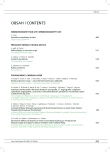The Correlation of Transcranial Colour‑ Coded Duplex Sonography, CT Angiography and Digital Subtraction Angiography in Patients with Atherosclerotic Disorders of Cerebral Arteries in Common Clinical Practice
Authors:
M. Roubec 1; D. Školoudík 1,2; R. Herzig 2; M. Bar 1; T. Jonszta 3; V. Procházka 3
; J. Chmelová 3; T. Fadrná 1; K. Langová 4
Authors‘ workplace:
Neurologická klinika FN Ostrava
1; Neurologická klinika LF UP a FN Olomouc
2; Ústav radiodiagnostický FN Ostrava
3; Ústav lékařské biofyziky LF UP v Olomouci
4
Published in:
Cesk Slov Neurol N 2009; 72/105(6): 542-547
Category:
Original Article
Overview
Objectives:
Atherosclerotic affection of cervical and cerebral arteries is one of the most common causes of ischemic stroke. Various neuroimaging
methods may be used in the detection of vascular pathology. The aim of the study was to compare intracranial vessel findings in stroke patients arising out of three different examination methods: transcranial colour-coded sonography (TCCS), CT angiography (CTA) and digital subtraction angiography (DSA) within two months of entering common clinical practice.
Methods:
A single-centre retrospective study was performed. Thirty-five patients fulfilling inclusion criteria were admitted to the study (25 males, 10 females, age 23–79, mean 59.7 ± 12.2 years). All patients were hospitalized in the course of the 12 months (January 2007 through December 2007) and all of them underwent TCCS, CTA and DSA angiography within two months. The internal carotid artery, M1 section of middle cerebral artery (M1), A1 section of anterior cerebral artery and P1 section of posterior cerebral artery (P1) were examined on both sides. Findings were divided into four groups: normal, stenosis < 50%, stenosis 50–99%, and occlusion. Sensitivity, specificity, positive (PPV) and negative (NPV) predictive values and Cohen’s kappa were statistically evaluated for comparison of the three methods.
Results:
Technical circumstances or insufficient temporal bone window meant that of a total of 280 vessels, 226 were evaluated. Sensitivity, specificity, PPV, NPV of CTA and TCCS in comparison with gold standard DSA were 75.0; 98.6; 80.0; 98.1%, and 81.3; 96.2; 61.9; 98.5%, respectively. Methods were in concordance: CTA and DSA 96.02% (κ = 0.694), TCCS and DSA 94.25% (κ = 0.628), CTA and TCCS 94.25% (κ = 0.619).
Conclusion:
Substantial agreement was established between all three methods. Two of the evaluated methods are sufficient for diagnosis when consenting, when the third method need not be undertaken.
Key words:
stenosis – occlusion – transcranial color--coded duplex sonography – CT angiography – digital subtraction angiography
Sources
1. Školoudík D, Škoda O, Bar M, Brozman M, Václavík D. Neurosonologie. Praha: Galén 2003: 198– 274.
2. Klötzsch C, Popescu O, Sliwka U, Mull M, Noth J.Detection of stenoses in the anterior circulation using frequency‑based transcranial color- coded sonography. Ultrasound Med Biol 2000; 26(4): 579– 584.
3. Hou WH, Liu X, Duan YY, Wang J, Sun SG, Deng JP et al. Evaluation of transcranial color‑ coded duplex sonography for cerebral artery stenosis or occlusion. Cerebrovasc Dis 2009; 27(5): 479– 484.
4. Nguyen- Huynh MN, Wintermark M, English J, Lam J, Vittinghoff E, Smith WS et al. How accurate is CT angiography in evaluating intracranial atherosclerotic disease? Stroke 2008; 39(4): 1184– 1188.
5. Baumgartner RW, Mattle HP, Schroth G. Assessment of >= 50 % and < 50 % intracranial stenoses by transcranial color‑ coded duplex sonography. Stroke 1999; 30(1): 87– 92.
6. Bash S, Villablanca JP, Jahan R, Duckwiler G, Tillis M, Kidwell C et al. Intracranial vascular stenosis and occlusive disease: evaluation with CT angiography, MR angiography, and digital subtraction angiography. AJNR Am J Neuroradiol 2005; 26(5): 1012– 1021.
7. Demchuk AM, Christou I, Wein TH, Felberg RA, Malkoff M, Grotta JC et al. Accuracy and criteria for localizing arterial occlusion with transcranial Doppler. J Neuroimaging 2000; 10(1): 1– 12.
8. Školoudík D, Šajerová I, Václavík D, Chudoba V. Stenózy intrakraniálních tepen – rizikové faktory a riziko cévní mozkové příhody. Cesk Slov Neurol N 2002; 65/ 98(5): 334– 339.
9. Warnock NG, Gandhi MR, Bergvall U, Powell T. Complications of intraarterial digital subtraction angiography in patients investigated for cerebral vascular disease. Br J Radiol 1993; 66(790): 855– 858.
10. Waugh JR, Sacharias N. Arteriographic complications in the DSA era. Radiology 1992; 182(1): 243– 246.
11. Herzig R, Burval S, Krupka B, Vlachová I, Urbánek K, Mares J. Comparison of ultrasonography, CT angiography, and digital subtraction angiography in severe carotid stenoses. Eur J Neurol 2004; 11(11): 774– 781.
12. Ferda J. CT angiografie. Praha: Galén 2004: 3– 112.
13. Bash S, Villablanca JP, Jahan R, Duckwiler G, Tillis M, Kidwell C et al. Intracranial vascular stenosis and occlusive disease: evaluation with CT angiography, MR angiography, and digital subtraction angiography. AJNR Am J Neuroradiol 2005; 26(5): 1012– 1021.
Labels
Paediatric neurology Neurosurgery NeurologyArticle was published in
Czech and Slovak Neurology and Neurosurgery

2009 Issue 6
- Memantine Eases Daily Life for Patients and Caregivers
- Memantine in Dementia Therapy – Current Findings and Possible Future Applications
- Metamizole at a Glance and in Practice – Effective Non-Opioid Analgesic for All Ages
- Advances in the Treatment of Myasthenia Gravis on the Horizon
Most read in this issue
- The Variants of the Catatonia
- Rett Syndrome
- Mental Nerve Neuropathy as a Manifestation of Systemic Malignancy
- Carpal Tunnel Syndrome
